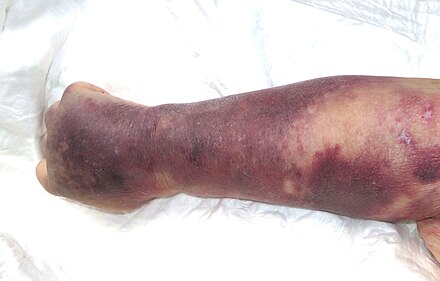Thrombocytopenia
Thrombocytopenia is a haematological condition characterised by abnormally low levels of platelets (thrombocytes) in the blood, resulting in prolonged or excessive bleeding. It is the most common coagulation disorder among intensive care patients, affecting a fifth of medical patients and a third of surgical patients.
A normal human platelet count ranges from 150,000 to 450,000 platelets per microliter (μL) of blood, with levels below 50,000/μL often requiring emergency treatment.
Signs and Symptoms

Thrombocytopenia is often asymptomatic and detected during routine complete blood counts. When symptoms are present, they may include external bleeding such as nosebleeds or bleeding gums, heavier or prolonged menstrual periods in women, and spontaneous bleeding under the skin leading to bruising. Petechiae—painless, pinpoint red or purple spots—and larger ecchymoses can appear anywhere on the body.

Individuals may also report malaise, fatigue, and general weakness. In severe cases, slow, continuous bleeding from wounds and large blood-filled bullae in the mouth may be observed. The severity of bruising and bleeding symptoms correlates with platelet count levels.

Causes
Thrombocytopenia can be inherited or acquired. Decreased platelet production may result from conditions such as dehydration, vitamin deficiencies, leukaemia, liver failure, sepsis, and hereditary syndromes. Increased platelet destruction can be immune-related, as seen in immune thrombocytopenic purpura (ITP), or non-immune, such as in thrombotic thrombocytopenic purpura (TTP) and disseminated intravascular coagulation. Medications like valproic acid, methotrexate, and certain chemotherapy agents can also induce thrombocytopenia through direct myelosuppression.

Other causes include laboratory errors, snakebites, Lyme disease, and specific genetic disorders.
Diagnosis
Diagnosis of thrombocytopenia involves laboratory tests such as full blood count, liver enzymes, kidney function, and peripheral blood smear. If the cause remains unclear, a bone marrow biopsy may be performed to differentiate between decreased production and increased destruction of platelets. In alcoholics, thrombocytopenia may be due to spleen enlargement, folate deficiency, or the toxic effects of alcohol on platelets, with counts rising after abstinence.
Treatment
The treatment approach depends on the severity and underlying cause of thrombocytopenia. General management may involve discontinuing causative drugs or treating underlying infections. Haematologists typically guide the treatment, which may include corticosteroids, lithium carbonate, or folate to stimulate platelet production.
Platelet Transfusions
Platelet transfusions are indicated for patients with significantly low platelet counts.
Thrombotic Thrombocytopenic Purpura (TTP)

TTP is a medical emergency requiring plasmapheresis to remove antibodies against the von Willebrand factor-cleaving protease ADAMTS-13 and to replenish active protease proteins.
Immune Thrombocytopenic Purpura (ITP)
Treatment for ITP varies, with many cases resolving spontaneously. Counts below 50,000/μL require monitoring, and counts below 10,000/μL typically necessitate treatment. Thrombopoetin analogues like romiplostim are effective for refractory ITP cases.
Heparin-Induced Thrombocytopenia (HIT)
Management of HIT involves discontinuing heparin and using direct thrombin inhibitors to prevent thrombosis. Platelet transfusions are generally avoided.
Congenital Amegakaryocytic Thrombocytopenia
Bone marrow or stem cell transplants are required for a cure, with platelet transfusions needed to manage bleeding risks.
Human-Induced Pluripotent Stem Cell-Derived Platelets
Research is ongoing to develop technology for creating platelets outside the human body.
Neonatal Thrombocytopenia
Thrombocytopenia in newborns, particularly those in neonatal intensive care units, is often mild and resolves without complications. Common causes include placental insufficiency and foetal hypoxia, with sepsis or necrotising enterocolitis being more significant in cases starting after 72 hours post-birth. Rapid pathogen identification via polymerase chain reaction tests is very important for managing these cases.
Self-assessment MCQs (single best answer)
What is thrombocytopenia?
What is the normal human platelet count range?
Which of the following is a common symptom of thrombocytopenia?
What is the recommended treatment for thrombotic thrombocytopenic purpura (TTP)?
Which medication is associated with immune thrombocytopenic purpura (ITP)?
What is a potential cause of thrombocytopenia in alcoholics?
How is neonatal thrombocytopenia commonly caused?
What is Heparin-Induced Thrombocytopenia (HIT) treated with?
Which diagnostic test is commonly performed to differentiate between decreased production and increased destruction of platelets?
What is the treatment for Congenital Amegakaryocytic Thrombocytopenia?
Dentaljuce
Dentaljuce provides Enhanced Continuing Professional Development (CPD) with GDC-approved Certificates for dental professionals worldwide.
Founded in 2009 by the award-winning Masters team from the School of Dentistry at the University of Birmingham, Dentaljuce has established itself as the leading platform for online CPD.
With over 100 high-quality online courses available for a single annual membership fee, Dentaljuce offers comprehensive e-learning designed for busy dental professionals.
The courses cover a complete range of topics, from clinical skills to patient communication, and are suitable for dentists, nurses, hygienists, therapists, students, and practice managers.
Dentaljuce features Dr. Aiden, a dentally trained AI-powered personal tutor available 24/7 to assist with queries and provide guidance through complex topics, enhancing the learning experience.
Check out our range of courses, or sign up now!


